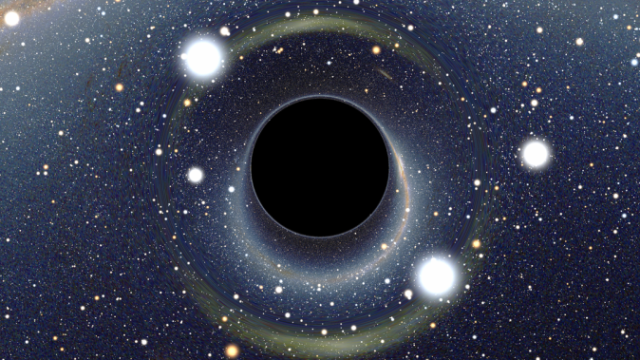Now you can watch as well as listen as world-renowned physicist Stephen Hawking expounds upon his latest ideas about the knotty black hole information paradox, playfully illustrated by chalkboard artist Andrew Park.
Hawking recently joined a long line of illustrious figures who have given the annual BBC Reith Lectures, founded in 1948, with the very first lectures in the series delivered by Bertrand Russell. And naturally he chose to talk about black holes, specifically the paradox created by his assertion in the 1970s that black holes give off radiation that causes them to gradually evaporate. The smaller the black hole, the faster this happens.
This has implications for whether or not it’s possible to retrieve information that falls into a black hole. Hawking assumed it would be lost. “Not only does God play dice, but he sometimes confuses us by throwing them where they can’t be seen,” he famously declared. This is OK in general relativity, but quantum mechanics holds that information must always be preserved. Hence the paradox.
For a while, physicists thought they had found an acceptable makeshift solution; Hawking even conceded a bet he’d made with Caltech’s John Preskill and Kip Thorne in 2004. That uneasy truce was shattered in 2012, when physicists at the Kavli Institute for Theoretical Physics published a controversial paper, pointing out serious flaws in the accepted solution. The debate has continued to rage ever since.

Last August, Hawking made waves yet again when he announced at a public lecture in Stockholm that there could be a means of escape if you fell into a black hole. (It was part of a weeklong conference on the paradox, co-hosted by Nordita and held at KTH Royal Institute of Technology.)
As Gizmodo’s Maddie Stone wrote at the time, “There are two ways this terrible situation could end: One, you become permanently stuck in a 2 dimensional hologram on the black hole’s edge (shitty, brah). Two, you bust right through into another universe.”
At the time, his ideas amounted to a short note posted to the arXiv, rather than a full paper, but he did say he was collaborating with Harvard string theorists Andrew Strominger and Malcolm Perry on a complete solution. That paper appeared on the arXiv last month, offering tantalising new details — at least for those able to parse the incredibly technical content. Fortunately Strominger translated a few things in a lengthy Q&A for Scientific American.
And now you can hear about it from Hawking himself. For your viewing pleasure, we give you Part 1, “Do Black Holes Have No Hair?”:
And here’s Part II, “Black Holes Ain’t as Black as They Are Painted”:
[via Open Culture and the BBC]
Top image: Artist’s concept of a black hole, via Wikimedia. Bottom image: Gerard ‘t Hooft and Stephen hawking in August 2015. Credit: Håkan Lindgren
